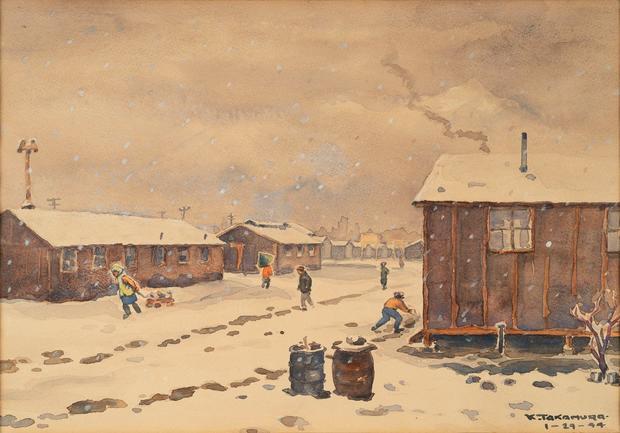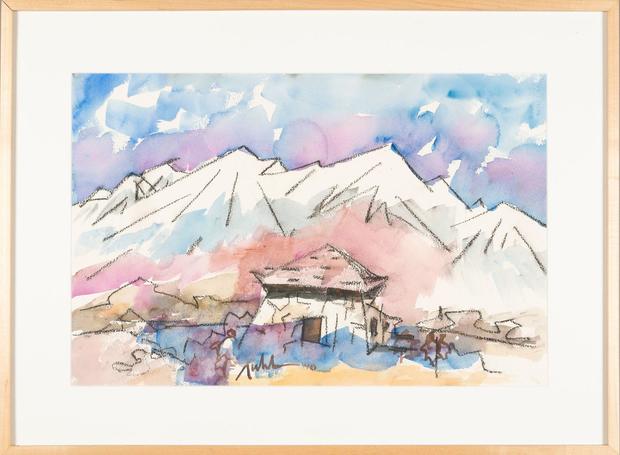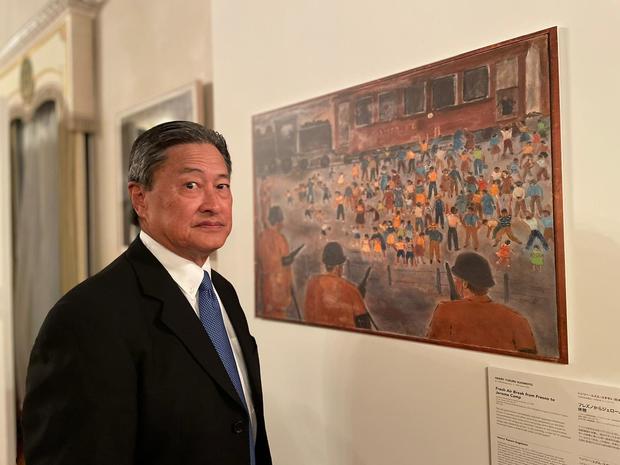Art by Japanese American prisoners depicts life in WWII detention camps
In an ink illustration, two siblings clutch their worldly possessions — a few bags and suitcases bearing the label "13660." The same digits are pinned to their clothing, denoting the number their family was assigned at the detention camp they are about to enter.
Elsewhere, a watercolor painting shows rows of army-style barracks in the dead of winter, detainees trudging between them through the snow.
These are just two of almost 20 works by Japanese American artists incarcerated in the United States during World War II displayed in Tokyo earlier this month. As well as shining a rare light on prisoners' experiences, the exhibition — and its location, at the official residence of US Ambassador to Japan, Rahm Emanuel — was symbolic of growing calls to better acknowledge a controversial chapter in American history.
The detention of Japanese Americans, most of whom were US citizens, was enacted by Franklin Roosevelt via Executive Order 9066 following the attack on Pearl Harbor in 1941. It was the largest single forced relocation in US history, with around 120,000 people of Japanese descent being stripped of their civil rights and incarcerated around the country.
While the US government formally apologized in 1988, granting $20,000 in reparations to each surviving prisoner, the trauma of that time shaped generations of Japanese and Asian Americans.
For Robert T. Fujioka, vice chair of California's Japanese American National Museum (JANM), which lent all of works in the exhibition, highlighting this history is more important than ever as racism and xenophobia toward people of Asian descent continue to surge in the wake of Covid-19.
"This whole racist situation has never been as bad, I think, since (World War II)," he told CNN at the exhibition reception.
"If we don't keep telling this story, and if we don't have people hear about it, do their research and learn about it, then we might as well just lay over," he added. "You have to constantly remind people what democracy is all about."
The artworks, some of which are now showing at the Museum of Modern Art in Wakayama, Japan, also serve to preserve disappearing first-hand memories of the camps. All the artists whose works were displayed have now passed away.
"It's gratifying that this exhibit is being shown in Japan by a prominent US official… because it demonstrates a commitment to remembering and sharing this history outside of the US," said Alice Yang, chair of the history department at the University of California Santa Cruz, who has extensively researched the legacy of Japanese American detention and the subsequent struggle for reparations.
"It also draws attention to the role of artists in documenting a visual record of the camp experience, (as) cameras were not allowed," added Yang, who was not directly involved in the exhibition.
Depicting incarceration
The art spans a range of media, from oil paintings to pen drawings. The themes are just as diverse. Providing everyday snapshots — from women doing laundry in open troughs, to men killing time with a game of cards — many of the works depict people continuing life as normally as possible.
Other pieces offer a glimpse into the inner lives and private turmoil of those incarcerated. Prominent artist Hisako Hibi, who moved to the US as a child before being imprisoned in California and Utah, painted several portraits of her children at the camps — including "Study" (pictured top), which shows them sitting at desks and writing on paper.
"As a mother with two young children, Hibi knew all too well about the challenges these women suffered as she painted and taught painting (in the camps)," Yang said. "The fact that Hibi produced over 70 paintings and numerous sketches while raising two kids at Topaz (a camp containing thousands of prisoners in Utah) is remarkable in itself."
Yang added that the collection's diversity reflects the varied experiences of detainees — perspectives that were overlooked by US officials at the time.
For instance, Hibi and fellow artist Miné Okubo's depictions of female prisoners' lives, such as a lack of privacy in shared bathrooms, contrasts with government accounts that "portrayed women as gold-star mothers… and camp employees," Yang said.
Detainees' attitudes toward the war and Roosevelt's executive order also varied greatly. Fujioka said his grandfather declared "the United States is the greatest country in the world" as he was being sent to Jerome War Relocation Center in Arkansas — despite the fact he had "tears just streaming down his face," the JANM vice chair added, describing his family's account. Visibly emotional as he spoke, Fujioka said that many of those incarcerated, including his mother, hoped their cooperation would "prove" their Americanness to their captors.
Others pushed back against the executive order — perhaps most famously Fred Korematsu, who resisted incarceration and went into hiding before being captured and imprisoned. He later sued the US government, although the Supreme Court ruled against him in 1944, an infamous decision that was eventually rejected by the same court in 2018.
Through it all, incarcerated artists documented what they could, using whatever materials were available. One artist, Henry Sugimoto, even painted on pillowcases, bedsheets and canvas mattress covers.
"I think everybody realized they had to capture the moment, just to preserve the unconscionability of the whole situation," said Fujioka. "They just knew there would come a time where this was important, (that) they were recording history."
Preserving a legacy
The location of the exhibition within the US ambassador's residence was as symbolic as the venue itself: The artworks hung in the very room where General Douglas MacArthur held his historic meeting with Emperor Hirohito after Japan's surrender in 1945.
It was selected for "all the history that's in this (drawing room and) in this building," Ambassador Rahm Emanuel told CNN.
The detention of Japanese Americans, Emanuel said, was a "shameful" chapter in American history. "But the American story is owning that shame, being accountable for it. And part of democracy, and part of America, is learning from our past," he added.
JANM President and CEO Ann Burroughs told CNN at the exhibition that the event offered "an opportunity to educate Japanese people about this extraordinarily dark period in American history… because it's as much Japanese history as it is American history."
The artworks also serve to highlight the difficulties the incarcerated generation faced upon release after the camps were closed. Many had lost their homes and businesses while imprisoned, leaving them little to return to.
The artist Sugimoto, known for his emotive oil paintings, was "practically destitute when he left camp," said Yang. Many of Sugimoto's pre-detention paintings, which he had put in storage, were auctioned off during the war and he received none of the proceeds. Another detainee, Henry Fukuhara, set aside his art career upon his release, as his family tried to recover and start a business, only resuming his drawing, painting and printmaking in the 1970s.
Some juggled their art with more pressing responsibilities — like Hibi, who single-handedly raised her two children after her husband's death by working in a garment factory, all while painting and attending art classes. Others went on to dedicate themselves to activism and community service, including the fight for reparations.
The exhibited artists and their art "tell you that you can never squash and turn off the human spirit, and there's an act of resilience," Ambassador Emanuel said. "There's a lesson from that, too."







